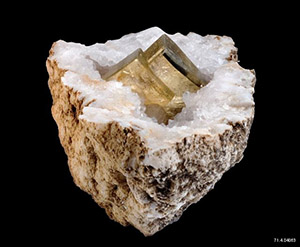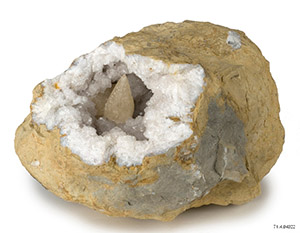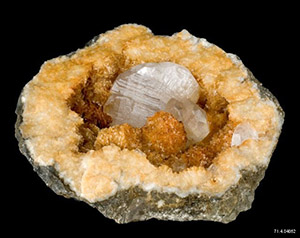Published February 9, 2021
Guest Blog: What’s in a Geode?
GeoFest is a fan-favorite festival at the Indiana State Museum, and it’s an event that’s all about rocks, gems and minerals. Visitors can purchase items from dozens of vendors from around the country, as well as enjoy interactive activities throughout the museum.
One of the rocks many people are most familiar with is the geode – a type of rock that you crack open to expose glittering crystals inside.
But, what’s in a geode, and how do they form? Our curator of geology explains in this guest blog.
 What’s in a Geode?
What’s in a Geode?
By Peggy Fisherkeller, curator of geology, Indiana State Museum and Historic Sites
For my job as curator of geology, I get to do some excellent things. One of my favorites is identifying mystery rocks.
It usually starts with an email that goes something like this: “I don’t know if this is the right place, but I have this rock…” Rock identification isn’t the most common skill, but amazingly, it doesn’t do as much as you’d think to make me popular at parties.

After that first exploratory email or phone call, we sometimes have to meet in person, because identifying from photographs can be tricky. Among the most common objects to walk through the doors are geodes.
A quintessential southern Indiana rock, geodes are mostly found in Morgan, Monroe, Brown, Lawrence and Washington counties. Most natives of those counties can tell a geode from an ordinary rock, but those of us not born and raised in southern Indiana might not know about these oddly-shaped, round rocks with nubbly surfaces. In fact, geodes are often suspected of being petrified human heads or dinosaur eggs!

The real origin of Indiana geodes has less to do with ancient animals and more to do with the chemistry of ancient oceans.
Some 350 million years ago, Indiana was the site of a shallow, salty sea. Geodes probably began as mineral nodules in the briny sea floor that were later replaced by other minerals, and the sea floor sediment eventually became limestone. Over time, groundwater full of dissolved minerals travelled through the geode-rich limestone bedrock, providing the source for a variety of crystal types. Much like rock candy – made by supersaturating water with sugar and hanging a string for crystals to form on as the sugary water cools – it usually takes an over-saturated fluid and something to attach to in order to form a crystal.

Geodes can have just one type of mineral inside, or many, depending on the generations of groundwater that have moved through. They can either be hollow with crystal-lined insides, or solid. In either case, geodes have a hard chalcedony exterior that preserves them as the softer limestone wears away and they remain behind.
Geodes can be found in the previously-mentioned Indiana counties, often in stream beds where they’ve ended up after weathering out of bedrock. Once you know what geodes are, they’re easily spotted. Make sure to check with landowners before exploring and collecting.
Or, come buy geodes of your own at GeoFest, February 19-21 at the Indiana State Museum. The rock and mineral show is included with purchase of general admission.









